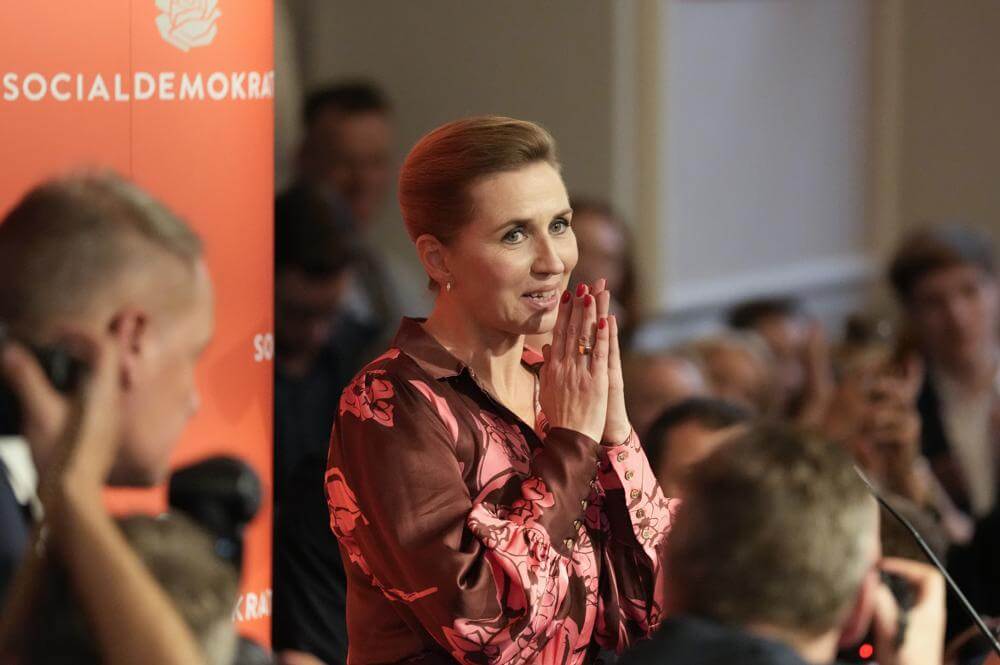Danish Prime Minister (PM) Mette Frederiksen tendered her resignation on Wednesday after her centre-left bloc secured a narrow victory in the national elections in order to explore options to form a coalition with political partners from across the spectrum.
The left-aligned coalition secured a one-seat majority after winning 90 seats in the 179-seat Parliament. Meanwhile, the right-wing bloc secured 73 seats in an election that saw the participation of 14 parties.
The remaining 16 seats were secured by the Moderates, two-time former PM Lars Lokke Rasmussen’s newly-formed centrist party. Experts had predicted that the Moderates would be critical “kingmakers” if the result were “evenly balanced.” However, after Frederiksen’s left-aligning coalition secured a majority, Rasmussen’s influence took a significant hit. Nevertheless, he is likely to participate in the coalition discussions with Frederiksen.
Frederiksen, who previously served as the employment minister and justice minister, is likely to secure her second term as PM. She became the country’s youngest-ever PM in 2019 at age 41.
Mit ihrem rechtspopulistischen, flüchtlingsfeindlichen und europaskeptischen Kurs haben die dänischen „Sozialdemokraten“ unter Mette Frederiksen erneut die Parlamentswahl in Dänemark🇩🇰 gewonnen und werden auch die nächste „Mitte-Links“-Regierung anführen. pic.twitter.com/KbP0FyiOEF
— Julian Röpcke🇺🇦 (@JulianRoepcke) November 2, 2022
She has been celebrated for her decisive stand on the Ukraine war after she increased defence spending to counter Russia’s invasion. She also paved the way for Denmark’s “zero refugee” policy, despite her opposition to restrictive immigration laws in the early 2000s.
While Danes supported her overall handling of the COVID-19 pandemic, her popularity took a hit in 2020 after she ordered the killing of 17 million minks to prevent the spread of the virus to humans and avoid any mutations.
After a Parliamentary Commission concluded this year that her government misled the population by suggesting a link between the mink population and the COVID outbreak, Frederiksen was forced to call for early elections.
Nevertheless, she continues to enjoy huge support among citizens, with a pre-election poll showing that 58% feel she is the best candidate to lead the country.
Frederiksen’s Social Democrats won 28% of the votes and secured 50 seats, the strongest support for the party in 20 years. Celebrating her victory, Frederiksen said, “Thanks to all Danes who have trusted us with your vote. It’s a huge vote of confidence. I know some of you have had doubts along the way.”
Recognising the narrow majority, however, PM Frederiksen said that the election result was evidence that “there is no longer a majority behind the government in its current form,” instigating her resignation.
Frederiksen’s re-election bid centred around her call to abandon the traditional political divide between the right- and left-wing parties and stressed the need for domestic unity amid international uncertainty.
Congratulations Mette Frederiksen on your mandate to lead Denmark in the next years.
— Roberta Metsola (@EP_President) November 2, 2022
Europe must stay united in standing up against autocracy & spiralling living costs.@Europarl_DK is a natural partner in promoting energy diversity, renewables & fighting climate change.
🇪🇺🇩🇰
In discussion with party leaders following the result, she said, “I wholeheartedly believe that with the climate crisis, inflation, war in Europe ... and a potential recession in the European economy, we must put the harsh words of the election campaign behind us and come to the negotiating table.”
Denmark is also facing critical shortages of nurses, hampering its public health system.
Unlike other recent elections in Europe that have resulted in the emergence of far-right leaders, such as in Italy and Sweden, the Danish election campaigns largely ignored the immigration issue. Copenhagen has arguably the most restrictive immigration laws in Europe and enjoys the support of parties across the political aisle.
However, Frederiksen’s political allies and opponents have expressed scepticism about her unifying strategy, making her goal of a “political middle” coalition difficult to achieve.
According to Sune Steffen Hansen, a public affairs consultant and former advisor to the Social Democrats, Frederiksen is currently in a catch-22 situation. He said, “She could opt for a straight left-wing bloc, which would mean going back on her campaign promise of political unity, or she can keep her word and risk upsetting her traditional allies.”
To this end, an expert warned that a government comprising mainstream parties from the right and the left could weaken the government and result in a “short” and “chaotic” tenure. Commentators have also raised concerns about an alliance with right-wing parties strengthening more radical parties in other parts of Europe.
Recognising this, Frederiksen acknowledged that forming such a coalition “will be very, very troublesome.” She said following the election result that setting up the government will “take some time” and require “compromises.”

